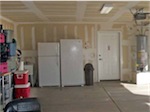The Importance of Low-E
Of the many window technologies developed in recent years, none has had as great an effect on window energy performance as the low-E (low-emittance) coating. A low-E coating is a microscopically thin, transparent metal layer applied to one of the glass surfaces in the sealed space of the insulating glass unit (IGU). In an ordinary IGU (no coating) about two-thirds of the heat transfer across the gap is via thermal radiation. Low-E coatings will block most of this heat loss – the net effect is that double-pane glass with low-E insulates as well as uncoated triple- or quad-pane glass. This allows window manufacturers to offer high-performance windows using proven double-glazed window designs – particularly important for operable windows. All of the U-factors listed in the Energy Star criteria can be met using double glazing with low-E.
When the heat loss is reduced, the room-side glass surface temperature is warmer during cold weather. The infrared photograph in Figure 4 presents a visual representation of comfort with three different windows installed side by side on a cold winter night. The two window units on the left are double pane insulating glass with a low-E coating, while the unit on the right is ordinary double glass (no coating).
Low-E coatings increase comfort by making the inside surface of glass warmer, leading to less heat transfer from the person to the window on a cold day. Also, people are more comfortable when a room’s escaping heat is reflected back at them by low-E coatings. A warmer surface on the inside of the glass also means less potential for condensation.
Spectrally Selective Low-E
Roughly half of the energy in sunlight is invisible to the human eye. Low-E coating manufacturers have learned how to design coatings that let most of the visible light pass through, with little tint or coloration, while either transmitting or blocking most of the solar heat. The different glass designs can be grouped into generic categories of high, medium, and low solar-heat gain.
Spectrally selective low-E coatings do a good job preventing winter heat loss and reducing summer heat gain while still allowing most of the visible light to enter the space (Figure 5).







